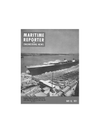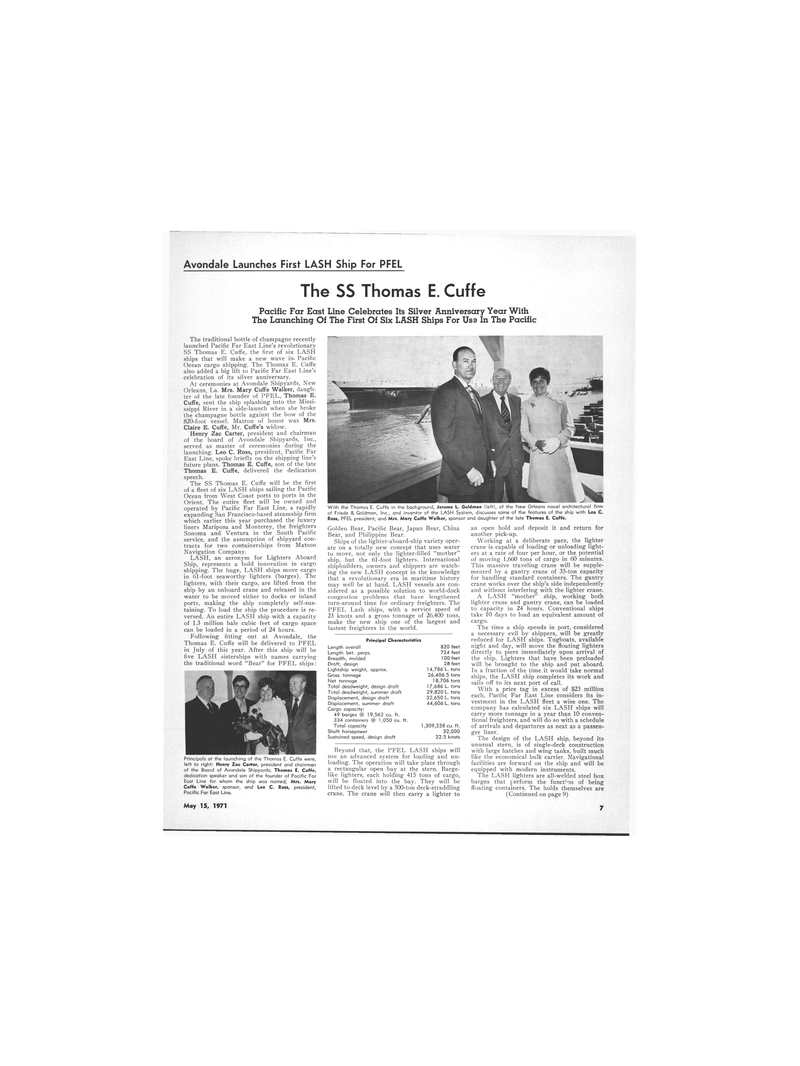
Page 5: of Maritime Reporter Magazine (May 15, 1971)
Read this page in Pdf, Flash or Html5 edition of May 15, 1971 Maritime Reporter Magazine
Avondale Launches First LASH Ship For PFEL
The SS Thomas E. Cuffe
Pacific Far East Line Celebrates Its Silver Anniversary Year With
The Launching Of The First Of Six LASH Ships For Use In The Pacific
The traditional bottle of champagne recently- launched Pacific Far East Line's revolutionary
SS Thomas E. Cuffe, the first of six LASH ships that will make a new wave in- Pacific
Ocean cargo shipping. The Thomas E. Cuffe also added a big lift to Pacific Far East Line's celebration of its silver anniversary.
At ceremonies at Avondale Shipyards, New
Orleans, La. Mrs. Mary Cuffe Walker, daugh- ter of the late founder of PFEL, Thomas E.
Cuffe, sent the ship splashing into the Missi- ssippi River in a side-launch when she broke the champagne bottle against the bow of the 820-foot vessel. Matron of honor was Mrs.
Claire E. Cuffe, Mr. Cuffe's widow.
Henry Zac Carter, president and chairman of the board of Avondale Shipyards, Inc., served as master of ceremonies during the launching. Leo C. Ross, president, Pacific Far
East Line, spoke briefly on the shipping line's future plans. Thomas E. Cuffe, son of the late
Thomas E. Cuffe, delivered the dedication speech
The SS Thomas E. Cuffe will be the first of a fleet of six LASH ships sailing the Pacific
Ocean from West Coast ports to ports in the
Orient. The entire fleet will be owned and operated by Pacific Far East Line, a rapidly expanding San Francisco-based steamship firm which earlier this year purchased the luxury liners Mariposa and Monterey, the freighters
Sonoma and Ventura in the South Pacific service, and the assumption of shipyard con- tracts for two containerships from Matson
Navigation Company.
LASH, an acronym for Lighters Aboard
Ship, represents a bold innovation in cargo shipping. The huge, LASH ships move cargo in 61-foot seaworthy lighters (barges). The lighters, with their cargo, are lifted from the ship by an onboard crane and released in the water to be moved either to docks or inland ports, making the ship completely self-sus- taining. To load the ship the procedure is re- versed. An entire LASH ship with a capacity of 1.3 million bale cubic feet of cargo space can be loaded in a period of 24 hours.
Following fitting out at Avondale, the
Thomas E. Cuffe will be delivered to PFEL in July of this year. After this ship will be five LASH sisterships with names carrying the traditional word "Bear" for PFEL ships:
Principals at the launching of the Thomas E. Cuffe were, left to right: Henry Zac Carter, president and chairman of the Board of Avondale Shipyards; Thomas E. Cuffe, dedication speaker and son of the founder of Pacific Far
East Line for whom the ship was named; Mrs. Mary
Cuffe Walker, sponsor, and Leo C. Ross, president,
Pacific Far East Line.
May 15, 1971 7
Golden Bear, Pacific Bear, Japan Bear, China
Bear, and Philippine Bear.
Ships of the lighter-aboard-ship variety oper- ate on a totally new concept that uses water to move, not only the lighter-filled "mother" ship, but the 61-foot lighters. International shipbuilders, owners and shippers are watch- ing the new LASH concept in the knowledge that a revolutionary era in maritime history may well be at hand. LASH vessels are con- sidered as a possible solution to world-dock congestion problems -that have lengthened turn-around time for ordinary freighters. The
PFEL Lash ships, with a service speed of 23 knots and a gross tonnage of 26,400 tons, make the new ship one of the largest and fastest freighters in the world.
Principal Characteristics
Length overall
Length bet. perps.
Breadth, molded
Draft, design
Lightship weight, approx.
Gross tonnage
Net tonnage
Total deadweight, design draft
Total deadweight, summer draft
Displacement, design draft
Displacement, summer draft
Cargo capacity: 49 barges @ 19,562 cu. ft. 334 containers @ 1,050 cu. ft.
Total capacity 1
Shaft horsepower
Sustained speed, design draft 820 feet 724 feet 100 feet 28 feet 14,786 L. tons 26,406.5 tons 1 8,706 tons 17,686 L. tons 29,820 L. tons 32,650 L. tons 44,606 L. tons 309,238 cu. ft. 32,000 22.5 knots
Beyond that, the PFEL LASH ships will use an advanced system for loading and un- loading. The operation will take place through a rectangular open bay at the stern. Barge- like lighters, each holding 415 tons of cargo, will be floated into the bay. They will be lifted to deck level by a 500-ton deck-straddling crane. The crane will then carry a lighter to an open hold and deposit it and return for another pick-up.
Working at a deliberate pace, the lighter crane is capable of loading or unloading light- ers at a rate of four per hour, or the potential of moving 1,660 tons of cargo in 60 minutes.
This massive traveling crane will be supple- mented by a gantry crane of 35-ton capacity for handling standard containers. The gantry crane works over the ship's side independently and without interfering with the lighter crane.
A LASH "mother" ship, working both lighter crane and gantry crane, can be loaded to capacity in 24 hours. Conventional ships take 10 days to load an equivalent amount of cargo.
The time a ship spends in port, considered a necessary evil by shippers, will be greatly reduced for LASH ships. Tugboats, available night and day, will move the floating lighters directly to piers immediately upon arrival of the ship. Lighters that have been preloaded will be brought to the ship and put aboard.
In a fraction of the time it would take normal ships, the LASH ship completes its work and sails off to its next port of call.
With a price tag in excess of $23 million each, Pacific Far East Line considers its in- vestment in the LASH fleet a wise one. The company has calculated six LASH ships will carry more tonnage in a year than 10 conven- tional freighters, and will do so with a schedule of arrivals and departures as neat as a passen- ger liner.
The design of the LASH ship, beyond its unusual stern, is of single-deck construction with large hatches and wing tanks, built much like the economical bulk carrier. Navigational facilities are forward on the ship and will be equipped with modern instruments.
The LASH lighters are all-welded steel box barges that perform the function of being floating containers. The holds themselves are (Continued on page 9)
With the Thomas E. Cuffe in the background, Jerome L. Goldman (left), of the New Orleans naval architectural firm of Friede & Goldman, Inc., and inventor of the LASH System, discusses some of the features of the ship with Leo C.
Ross, PFEL president, and Mrs. Mary Cuffe Walker, sponsor and daughter of the late Thomas E. Cuffe.

 4
4

 6
6
